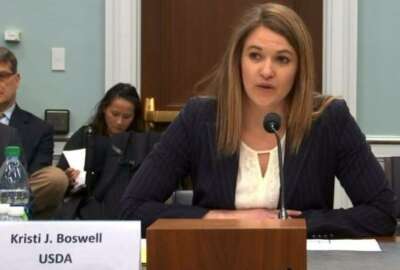
Faced with possible relocation, USDA’s ERS employees vote to unionize
Employees at the Economic Research Service (ERS) voted 138 to 4 to join a collective bargaining unit with the American Federation of Government Employees, days ...
Amid possible plans to relocate the workforce outside of the Washington, D.C., metropolitan area to a still undetermined location, employees at the Agriculture Department’s Economic Research Service (ERS) have voted to unionize.
ERS employees on Thursday voted 138 to 4 to unionize under the American Federation of Government Employees. USDA had determined that 204 ERS employees would be eligible to cast a ballot. In total, ERS has roughly 250 employees, according to AFGE.
The size of the ERS workforce has shrunk in recent months, employees said. Two employees left for the Congressional Budget Office two weeks ago, and another has joined the Millennium Challenge Corporation, an ERS employee told reporters.
The Federal Labor Relations Authority had counted 19 ballots that were challenged, but two of them were resolved and the remaining 17 weren’t considered to be determinative to the final result.
A few dozen people gathered in a conference room at the USDA’s facility in Patriots Plaza in Washington to watch as the FLRA counted ballots. When the final tally was announced, the room erupted into cheers.
Voting opened at 11 a.m. Thursday, and a line wrapped around the hall, said Peter Winch, a special assistant with AFGE who helped organize the unionization vote.
The bargaining unit will consist of professional and non-professional ERS employees, a matter that the employees also voted on Thursday.
FLRA within the next five days will issue a notice of exclusive representation.
“That gives us legal standing, and the agency has to deal with us with a good faith,” Winch said.
The vote to unionize comes a few days after Agriculture Secretary Sonny Perdue further narrowed down the list of possible sites for the relocation of ERS and the National Institute of Food and Agriculture (NIFA). NIFA employees are planning their own unionization vote later this month.
USDA has selected the greater Kansas City region, North Carolina’s research triangle region and multiple sites in Indiana.
St. Louis, Missouri, and Madison, Wisconsin, are also under consideration “should the top three locations not suit USDA’s needs,” the department said last week.
Sandra Salstrom, a lobbyist with AFGE, said ERS employees reached out to the union with their concerns about the potential USDA relocation. Though AFGE said it hasn’t promised ERS employees that it can stop the relocation, Salstrom said the union has been working with the House Appropriations Committee and other members of Congress to try to delay the USDA relocation.
Democrats on the House Appropriations Agriculture, Rural Development and Food and Drug Administration Subcommittee and other lawmakers in the national capital region have been highly critical of USDA’s planned relocation.
“We’re very interested in using the General Services Administration process to review their lease if they’re trying to move to another city,” Winch said. “This lease is $5 million. If this lease is $5 million, and if it’s anything more than $3 million it’s supposed to be reviewed by GSA. Apparently [USDA] is trying to avoid that kind of review either by using USDA space or some combination of space. If we find a violation, we would definitely write to Congress.”
Once the department chooses a final site location, USDA has told employees they will receive a notice of relocation, and they’ll have 30 days to decide whether to move. If employees do accept the relocation, they’ll have 90 days to move, an ERS employee told reporters.
Employees have told AFGE they’re concerned about the time they’d have to find housing or new schools for their children.
Pay is also a concern.
A GS-10, step 1 employee in the Washington metro locality pay area earned $63,332 in 2019, according to Office of Personnel Management pay tables.
But if USDA chose to relocate ERS and NIFA employees to the Kansas City area, for example, that same employee would earn $57,103 in 2019. Locality pay is based on a comparison from the Bureau of Labor Statistics, which uses the National Compensation Survey to measure non-federal compensation in a particular labor market and compare it to federal pay for GS employees who perform similar work in the same region. It isn’t, despite common perceptions, based on cost-of-living.
USDA has said a lower cost of living and shorter commute for its employees, as well as real estate costs and proximity to stakeholders, will factor into the department’s final site decision. The Agriculture Department has said it’s interested in finding a new location that would offer a lower cost of living for its employees.
Copyright © 2024 Federal News Network. All rights reserved. This website is not intended for users located within the European Economic Area.
Nicole Ogrysko is a reporter for Federal News Network focusing on the federal workforce and federal pay and benefits.
Follow @nogryskoWFED






